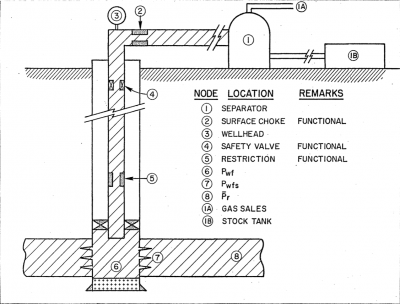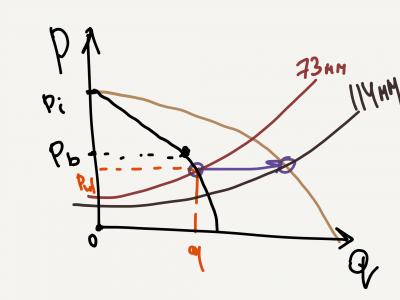Well Nodal Analysis
Contents
Well Nodal Analysis
Well Nodal Analysis is the fundamental petroleum engineering technique published in 1979 by Joe Mach [1]. For his invention Joe Mach was honored as a JPT Legend of Production and Operations in 2009[2].
Well Nodal Analysis is used to predict the well rate and performance by combining the reservoir inflow with the wellbore lift capacity by intersecting the IPR and VLP curves on a pressure vs rate plot.
For the given reservoir Well Nodal Analysis calculates how much oil, water and gas can be produced by the given well.
PQplot is a Well Nodal Analysis software available online at www.pengtools.com.
The Power of Well Nodal Analysis

Well Nodal Analysis is the cornerstone of petroleum engineering. It allows to:
- Calculate the well production potential and identify the performance gaps to maximize oil and gas production.
- Evaluate the various well nodes impact on production. Nodes: reservoir, perforation, tubing string, restrictions, downhole safety valves, the surface chokes, the surface flow lines and separator.
Typical Applications
- Estimation of well production potential and absolute open flow (AOF)
- Tubing sizing
- Selection of the operating wellhead pressures
- Artificial lift design. Gas lift. ESP sizing.
- Sensitivity studies
Math and Physics
Well Nodal Analysis is done on a pressure vs rate plot. IPR and VLP curves intersect at well operating point.
Well IPR curve: Darcy's law, Vogel's IPR, Composite IPR.
Well VLP curve: Hagedorn and Brown multiphase flow correlation
Well Nodal Analysis Example
SGg=0.65
SGo=35 API
See also
References
- ↑ 1.0 1.1
Mach, Joe; Proano, Eduardo; Brown, Kermit E. (1979). "A Nodal Approach For Applying Systems Analysis To The Flowing And Artificial Lift Oil Or Gas Well"
 (SPE-8025-MS). Society of Petroleum Engineers.
(SPE-8025-MS). Society of Petroleum Engineers.
- ↑
JPT, staff (2009). "Legends of Production and Operation"
 . Journal of Petroleum Technology. Society of Petroleum Engineers (SPE-1209-0033-JPT).
. Journal of Petroleum Technology. Society of Petroleum Engineers (SPE-1209-0033-JPT).

